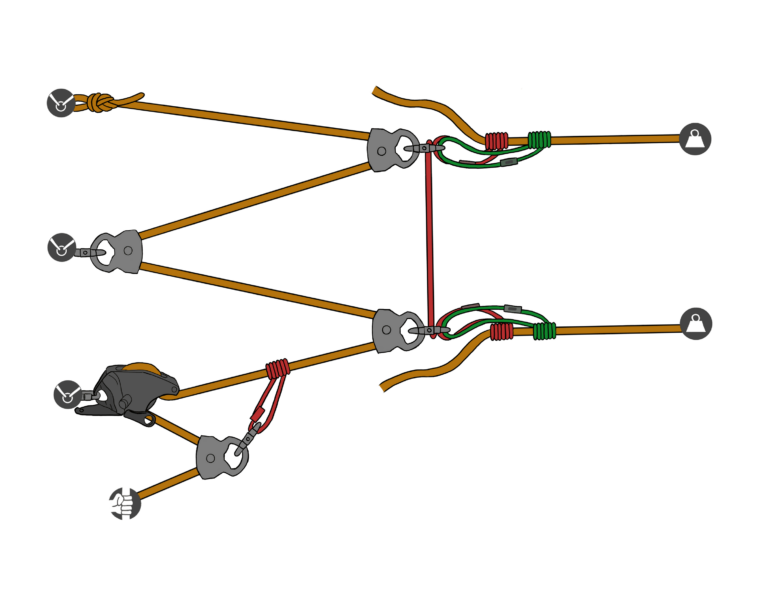In rope rescue operations, the importance of proper knot selection cannot be overstated. Beyond tying secure connections, the right knots can significantly impact the efficiency, safety, and effectiveness of force multiplication within a system. For professionals in fire service and search and rescue (SAR), understanding how each knot influences load distribution and force management is key to executing high-stakes rescues. This first part of our series focuses on the strategic selection of knots to optimize force multiplication, helping rescue teams maximize efficiency and safety.
Key Considerations When Choosing Knots for Force Multiplication
1. Load Distribution and Knot Efficiency
Each knot affects load distribution differently within a rescue system, and understanding these nuances is critical when force multiplication is involved. Knots like the figure-eight follow-through or alpine butterfly are widely used in rescue operations due to their ability to distribute loads evenly across multiple directions. This ensures that, in a mechanical advantage system, forces are managed without compromising the integrity of the setup.
- Figure-Eight Follow-Through: Commonly used for secure, strong connections, this knot distributes force evenly, reducing pressure on a single strand.
- Alpine Butterfly: This knot is ideal for midline applications, offering strength while isolating the load without causing excessive friction on the rope.
Why It Matters: Effective load distribution is essential in rope rescue, as it directly impacts the safety and durability of mechanical advantage systems. By selecting knots that optimize load handling, rescuers can maintain system integrity even under significant strain.
2. Friction and Force Transfer
Knots also influence friction and the way forces are transferred within a rope system. In rescue scenarios, managing friction is crucial, as excessive friction can reduce mechanical advantage, making the system less efficient and more strenuous for rescuers. The bowline and double fisherman’s knot are examples of knots with moderate friction, suitable for applications where friction control is critical.
- Bowline: Known for its ease of untying even after heavy loading, the bowline has moderate friction and offers a solid connection without compromising rope strength.
- Double Fisherman’s Knot: Provides a reliable end-to-end connection, balancing friction control with high holding strength, making it useful in tandem prusik systems.
Why It Matters: Minimizing unnecessary friction allows for smoother force transfer in mechanical advantage setups, making it easier to move loads efficiently. When used in systems like highlines or mainline belays, selecting low-friction knots can reduce rescuer fatigue and improve system performance.
3. Knot Security and Safety Under Load
Security is paramount in rope rescue, particularly in systems that handle dynamic loads. Certain knots provide better resistance to slippage and untying under tension, such as the double overhand or barrel knot. These knots are designed to stay tied, even under the weight of a moving load, making them suitable for critical points in force-multiplying systems.
- Double Overhand: Offers high security in applications where knot stability is essential, often used as a backup for primary knots.
- Barrel Knot: With excellent holding strength and resistance to loosening, the barrel knot is ideal for applications that involve continuous load shifts.
Why It Matters: Knot security ensures that connections remain stable throughout the rescue, particularly in scenarios involving dynamic forces. Choosing stable, secure knots allows for a safer, more reliable system.
4. Adaptability for Mechanical Advantage Setups
Flexibility is another critical factor in knot selection for force multiplication. Knots that are easily adjustable, like the prusik or klemheist, enable rescuers to adapt quickly to changing circumstances, which is vital when setting up or modifying mechanical advantage systems on the go.
- Prusik Knot: A staple in rescue operations, the prusik knot offers both gripping power and flexibility, making it a go-to for adjustable mechanical advantage.
- Klemheist Knot: Similar to the prusik but with greater holding strength on static ropes, this knot is useful for controlled adjustments in a force-multiplying system.
Why It Matters: Adaptable knots allow rescuers to respond efficiently to unpredictable conditions in the field. By selecting knots that can be adjusted without compromising security, teams can better manage complex rescues and ensure system efficiency.
Conclusion: The Role of Knot Choice in Effective Force Multiplication
In the world of rope rescue, every detail matters, and knot choice plays a foundational role in achieving safe, effective, and efficient force multiplication. Whether distributing loads, managing friction, ensuring knot security, or allowing for on-the-fly adaptability, the right knot selection can make all the difference. By focusing on these key considerations, fire service and SAR teams can better control force within their systems, leading to more successful and streamlined rescue operations.
Stay tuned for Part 2, where we’ll dive into how knots interact with high-directional and anchor systems to maximize safety and efficiency in complex rescues.
- New Rigging Lab Academy Release: Knot Craft(Opens in a new browser tab)
- Knot Craft and Knot Passing(Opens in a new browser tab)
- Knot Mastery: The Foundation of Rope Rescue(Opens in a new browser tab)
- Figure 8 – Eights | Knots & Pulleys in Rope Rigging Systems Vol.1 Segment 3(Opens in a new browser tab)
- How much strength does my rope loose when I tie it in a knot?(Opens in a new browser tab)
Peace on your Days
Lance










